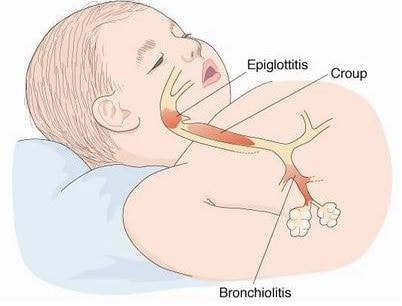Stridor
What is Stridor?
Stridor is a high-pitched, whistling sound caused by an interruption of the air flow. It is due to an obstruction in the windpipe or larynx which is easily noticed when the person breathes in and sometimes it is also noticeable when exhaling.


Young children are more affected of stridor as compared to adults,. This inspiratory sound must not be confused with stertor which is a sound produced in the pharynx.
Types of Stridor
The timing and noise of a child’s rackety breathing serve as the clues as to what type of airway disorder is present. The three types of stridor include:
- Inspiratory Stridor – This is the most common type of stridor that usually occurs in kids with croup. It comes up when the tissue just above the vocal cords or the glottis is blocked. It could also indicate a severe obstruction of the airway from acute conditions like epiglottitis.
- Expiratory Stridor – This happens when the child exhales some air out and it specifies a complication further down the trachea.
- Biphasic Stridor –It indicates a subglottic or glottic lesion.
Stridor Lung Sounds
Stridor breath sounds can be heard clearly when the person breathes, since the sound of wheezing is loud and high-pitched. The sound becomes noticeable when the person inhales and exhales.
These sounds are often heard without the use of a stethoscope, but it can also be specified out using the device in order to single out an area with greatest intensity that is correlated with the airway blockage.
This is usually at the thoracic inlet or at the larynx. It can be heard the loudest over the extrathoracic airways over the thorax. They are frequently wrongly identified as pulmonary wheezes.
Causes
Any actions that can constrict the breathing passages can cause stridor. In the case of infants, the indication of stridor is a congenital disorder such as laryngomalacia; which is caused by the tissues and structures that obstructs the airway, paralysis of the vocal cord, and subglottic stenosis where the larynx is too narrow.
An infection like pappillomatosis or croup may also be the cause, or it sometimes occurs after a trauma or an aspirated solid in the body.
Symptoms
Stridor itself is a symptom and not a disease or condition. It happens when an illness or an abnormality in the throat is forced through the narrowed airways. A foreign object swallowed will result to coughing or choking due to the obstruction of the breathing passages.
A person produces the high-pitched wheezing sounds during inhalation and exhalation of air. An abnormal and fast breathing may also occur. Cyanosis might be present which turns the skin blue in color due to the insufficient oxygenation of blood. Slowed level of consciousness can be a late sign.
Diagnosis
Neonatologists and pediatricians diagnose a newborn with stridor by first checking any heart defects that are present or neurological disorders that could cause vocal cord paralysis which can be life threatening. If the noisy breathing of the neonate is not revealed through any of the examinations, then it is presumed that the air passages are the reason for the problem.
The physicians or pulmonary specialists will usually listen to the breathing of an older child or adult in order to estimate the exact location of the obstructed airway passage. The sporadic sounds of breathing can become irregular at times of eating or when the person is on a standing or lying position, as well as the existence or nonappearance of any signs of infection and information to help determine the cause of stridor.
There are instances when physicians find it hard to tell the difference between stridor and wheezing that is caused by asthma. Nonetheless, a careful examination and an exact history of the breathing problem usually help differentiate the two sounds.
The extent of the blockage can be based on some assessment of a patient’s features through their level of consciousness, skin complexion, movements of the chest and breathing rate.
To know the correct location of the obstruction, an X-ray, examination of the larynx, and the use of bronchoscope or laryngoscope can help. CT scans and MRI scans may be useful as well especially if a surgical treatment is required.
Pulse oximetry and flow-volume loops are tools that are used for diagnosis in order to measure the amount of air that flows through the airways and the available oxygen. Pulmonary function tests are also possible.
Treatment
The treatment for stridor varies upon numerous factors, like the severity of the problem and the primary cause of the noisy breathing. A child’s treatment is modified to meet the unique needs. A group of specialists provide a multidisciplinary care to the child.
Treatment options may involve:
- Observation – This is for those who only have a minor obstruction of the airway like that of mild subglottic stenosis or laryngomalacia.
- Medications – This for the reduction of the airway swelling.
- Endoscopic surgery – It involves the removal of any obstructions of the breathing passages or for airway expansion through the trachea. In most cases, it is done through a scope.
- Open surgery – It’s done to fix any scarring and blockage through an outside incision.
References:
Stridor (Noisy Breathing) at http://www.chop.edu/conditions-diseases/stridor-noisy-breathing#.VhTSfvmqqkr
http://www.healthofchildren.com/A/Asthma.html
What causes stridor? 14 possible conditions at http://www.healthline.com/symptom/stridor
Carpes LF, Kozak FK, Leblanc JG, et al (2011 Jun). Assessment of vocal fold mobility before and after cardiothoracic surgery in children. Arch Otolaryngol Head Neck Surg. 137(6):571-5.
Bent J (2006 Jul). Pediatric laryngotracheal obstruction: current perspectives on stridor. Laryngoscope. 116(7):1059-70.
Bailey BJ, Calhoun KH, Healy GB, eds (2001). Head & Neck Surgery – Otolaryngology. 3rd ed. Philadelphia, PA: Lippincott, Williams, & Wilkins.
